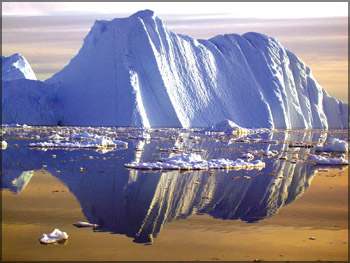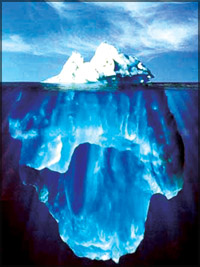|
 Ice
Age: Ice
Age:
When glaciers covered the Earth
Manny, a depressed woolly
mammoth, Sid, a fast-talking sloth, an acorn-crazed squirrel named Scrat
and the devilish sabre-toothed tiger named Diego; all these characters
would remind you in a trice(instantly) of the animated movie, Ice Age,
which shows a period where Earth is dominated by sub-zero temperatures.
This movie could be enjoyed by children like you as well as adults,
but did you know that such a phenomenon (remarkable happening) is really
associated with Earth?
An ice age is defined as a period of long-term reduction in the
temperature of the Earth's climate, which results in an expansion of the
continental ice sheets, polar ice sheets and mountain glaciers.
Glaciologically, ice age is often used to mean a period of ice sheets in
the northern and southern hemispheres.
If you go by this definition, does it mean that we are still in an
ice age because the Greenland and Antarctic ice sheets still exist? To
get rid of this ambiguity (uncertainty), ice age is used to refer to
colder periods with extensive ice sheets over the North American and
Eurasian continents, when the last few million years are considered.
In this sense, the most recent ice age ended about 10,000 years ago.
***
Major ice ages
It is said that there have been at least four major ice ages in the
Earth's past. Interestingly, outside of these periods, the Earth is said
to have been free of any ice even in high latitudes, although now we
find quite a lot of ice when the entire globe is considered.
The earliest ice age, called the Huronian, is believed to have
existed around 2.7 to 2.3 billion years ago during the early Proterozoic
Eon.
 The
earliest well-documented ice age, and probably the most severe ice age
of the last billion years, is said to have occurred from 850 to 630
million years ago in the Cryogenian period and may have made Earth look
like a 'Snowball Earth' in which permanent ice covered the entire globe.
This is said to have ended very rapidly as water vapour returned to
Earth's atmosphere. The
earliest well-documented ice age, and probably the most severe ice age
of the last billion years, is said to have occurred from 850 to 630
million years ago in the Cryogenian period and may have made Earth look
like a 'Snowball Earth' in which permanent ice covered the entire globe.
This is said to have ended very rapidly as water vapour returned to
Earth's atmosphere.
A minor ice age known as the Andean-Saharan, has occurred around 460
to 430 million years ago, during the Late Ordovician and the Silurian
period. There have been extensive polar ice caps at intervals from 350
to 260 million years ago, during the Carboniferous and early Permian
Periods, associated with the Karoo Ice Age.
The present ice age began 40 million years ago with the growth of an
ice sheet in Antarctica. It had increased during the late Pliocene,
around three million years ago, with the spread of ice sheets in the
Northern Hemisphere.
Since then, the world has seen cycles of glaciation with ice sheets
advancing and retreating on 40,000 and 100,000 year time scales. The
most recent glacial period ended about ten thousand years ago.
***
Evidence of ice ages
There are three main types of evidence for ice ages - geological,
chemical and paleontological.
Geological evidence for ice ages comes in various forms, including
rock rubbing and scratching, glacial moraines (mass of stones),
drumlins, valley cutting, and the deposition of till and glacial
erratics. 'Till' refers to various rocks mixed with ice when glaciers
are created, and 'glacial erratics' are rocks which reside in an area
which deviate (differ) a lot in size and type of the surrounding rocks.
When glaciers are created, they gradually erase the geological
evidence, making it difficult to understand the origin. It has taken
some time for the current theory to be worked out because of this.
 The
chemical evidence mainly consists of variations in the ratios of
isotopes in fossils present in sediments and sedimentary rocks, ocean
sediment cores, and for the most recent glacial periods, ice cores. The
chemical evidence mainly consists of variations in the ratios of
isotopes in fossils present in sediments and sedimentary rocks, ocean
sediment cores, and for the most recent glacial periods, ice cores.
Because water containing heavier isotopes has a higher heat of
evaporation, its proportion decreases with colder conditions. This
allows a temperature record to be constructed. This is studied to get
evidence about ice ages.
For your information, sedimentary rocks are one kind of the three
main rock types on Earth, and it contains common rock types such as
chalk, limestone, dolomite and sandstone. Furthermore, 'isotope' is a
term which appears in Chemistry, which in simple terms, means a form of
the several different forms of an element where each has a different
atomic mass.
The paleontological evidence or, in other words, evidence gained by
studying prehistoric life forms on Earth through analysing fossils,
consists of changes in the geographical distribution of fossils. During
a glacial period, cold-adapted organisms spread into lower regions, and
organisms that prefer warmer conditions become extinct or are pushed off
into lower latitudes.
This simple observation can reveal when there have been ice ages.
However, this evidence is also difficult to interpret due to a few
reasons. Firstly, it requires sequences of rocks which cover a long
time-span and a wide range of elevations which easily correlate
(connect).
Apart from that, ancient organisms which survive for several million
years without change and whose temperature preferences are easily
diagnosed have to be identified. Finally, finding the relevant fossils
requires a lot of luck.
Compiled by Aravinda Dassanayake |
